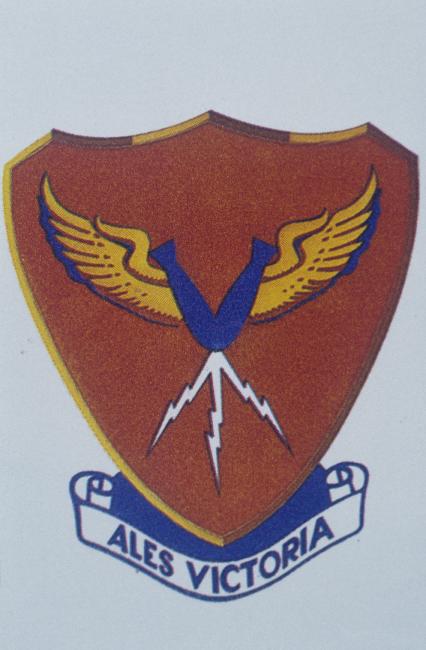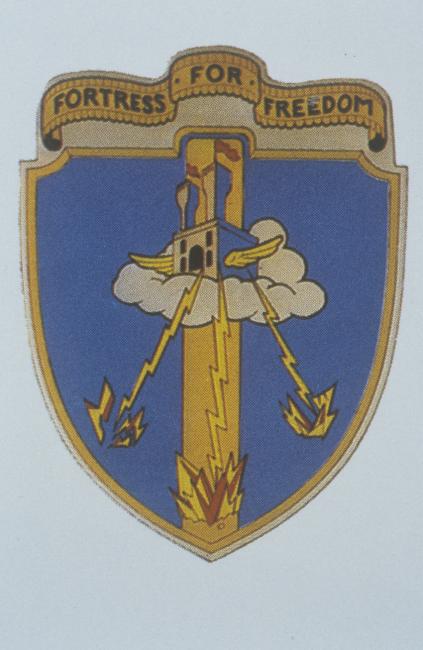VIII Bomber Command 119
3 November 1943![An Illustration of the Wilhelmshaven raid, 3 November 1943. Image stamped on reverse: '10 Nov 1943.' [stamp], '292478.'[Censor no.] Printed caption on reverse: 'THE BIGGEST EVER DAY RAID: By US Fortresses and Liberators on Wilhelmshaven- escorted all the way by fighters. Special Sphere drawings. THE SCENE OVER WILHELMSHAVEN JUST AS OUT BOMBERS WERE LEAVING THE TARGET ON WEDNESDAY, NOVEMVER 3RD. AFTER THE BIGGEST DAYLIGHT RAID EVER CARRIED OUT OVER GERMANY. IN THE TOP RIGHT HAND OF THIS DRAWING, LIGHTNING](https://assets.americanairmuseum.com/s3fs-public/freeman/media-418517.jpg)
Corrected a typo in the photo caption.
Object Number - FRE 9010 - An Illustration of the Wilhelmshaven raid, 3 November 1943. Image stamped on reverse: '10 Nov 1943.' [stamp], '292478.'[Censor no.] Printed caption...
Description
October 1943 turned out to be the worst loss rate for 8th Air Force for the entire war. 2,145 B-17s and 303 B-24s had been dispatched on missions. 163 B-17s had been lost (lost rate 7.5991%) and 9 B-24s were lost (loss rate 2.9703%). These loss rates meant that the B-17 crews chances of completing a 25-mission tour was only 28.32%. The losses on the 10-Oct-43 mission to Munster of 30 aircraft, followed by the devastating losses of 60 aircraft on the Second Schweinfurt mission of 14-Oct-43, caused the the USAAF high command to re-think the whole theory that the bombers could effectively protect themselves without long range fighter escort and some even questioned the whole strategy of "daylight bombing." With the arrival of the 55FG with P-38 Lightnings at Nuthampstead on 14-Sep-43 and the achievement of operational status on 15-Oct-43, there was a least some optimism of USAAF high command the P-38 would stem the losses, even though it was not particularly suited for "mixing it up" with the Bf-109s and Fw-190's of the Luftwaffe. The 55th had been "cutting their teeth" all during the latter half of October 1943 and were now thought to be fully qualified to support another "big" bombing mission to Germany.
On 3-Nov-43, the 8th Air Force went back to attacking Germany with a vengeance. The 3-Nov-43 mission was an all-out dispatch of 438 B-17s and 117 B-24s to bomb the German port areas of Wilhelmshaven, Germany. The mission would also be supported by 333 P-47s providing penetration and withdrawal support and 45 P-38s which would go all the way to the target and back with the bombers.
The mission consisted of three elements. The first element was a combined "maximum effort" force of 217 B-17s from 1st Bomb Division that included: 91BG (24); 92BG (25); 303BG (23); 305BG (20); 306BG (25); 351BG (25); 379BG (24); 381BG (27); and 384BG (24) dispatched to Wilhelmahaven, Germany. 211 aircraft of this element were effective on the target. 6 aircraft (2.765% loss rate) Failed to Return (FTR) 48KIA 12POW. 31 aircraft were damaged. 11 airmen in aircraft that returned were Wounded in Action (WIA). The bomber gunners of this element claimed 20-3-23 on attacking German aircraft.
The second element was a combined "maximum effort" force of 221 B-17s from 3rd Bomb Division that included: 94BG (33); 95BG (27); 96BG (50); 100BG (26); 385BG (27); 388BG (30); and 390BG (28) dispatched to bomb Wilhelmshaven, Germany. 212 aircraft of this element were effective on the target. Only 1 aircraft Failed to Return (FTR) (0.045% loss rate) 8KIA 2POW. 11 aircraft were damaged. Only 1 airman in a returning aircraft was wounded. The bomber gunners in this element claim 1-0-1 of attacking German aircraft.
NOTE: 11 PFF B-17s from 485BG were interspersed in the 1BD and 2BD formations and used H2X radar to identify the target and assist the bombardiers to effectively determine "bombs away."
The third element was a combined "maximum effort" force of 117 B-24s from 2nd Bomb Division that included: 44BG (28); 93BG (28); 389BG (33); and 392BG (28) dispatched to bomb Wilhelmshaven, Germany. 105 aircraft were effective on the target. There were NO losses or claims in this element, but 5 aircraft were damaged.
Fighter support (cf. VIII FC FO-168) from the 45 P-38s dispatched claimed 3-5-5 of attacking enemy aircraft. The 333 P-47s accounted for another 11-0-2 of attacking enemy aircraft.
Consideration must be given to the fact that the bomber formations were not attacked by the massive fighter formations put up by the Luftwaffe against the attacks at Munster and Schweinfurt, and the penetration was not as deep as that at Schweinfurt. However, credit must be given to the fighters for keeping the Luftwaffe from the bomber formations. 2 of the B-17s that were lost were involved in mid-air collisions. 566 bombers were dispatched and only 7 were lost (1.236%) which is a vast improvement from the 7.559% loss rate experienced in October 1943. Their was some relief, at last, and a boost in morale that this air war could be won.
Mission Details
WILHELMSHAVEN
Description: HARBOUR INSTALLATION
Aircraft Type: B-24 Liberator
Notes: One B-24 managed to drop 4 X 1000GP on the Initial Point.

- Unit Hierarchy: Group
- Air Force: Eighth Air Force
- Type Category: Bombardment

- Unit Hierarchy: Group
- Air Force: Eighth Air Force
- Type Category: Bombardment

- Unit Hierarchy: Group
- Air Force: Eighth Air Force
- Type Category: Bombardment

- Unit Hierarchy: Group
- Air Force: Eighth Air Force
- Type Category: Bombardment
Mission Statistics
- Tonnage Dropped: 308.45
- Aircraft sent: 120
- Aircraft effective: 108
- Aircraft damaged: 5
WILHELMSHAVEN
Description: NAVAL BASE
Aircraft Type: B-17 Flying Fortress
Notes: 482nd Bomb Group contributes 11 Pathfinder (PFF) aircraft dispersed among the elements on this attack. Fighter opposition was mainly concentrated on the first wave. This wave and the third did not encounter as many German fighters. 96th Bomb Group is the first to fly A, B and C formations (double strength) with a despatch of 50 aircraft.
![Three airmen of the 100th Bomb Group, Lieutenant Kenneth Menzie, Lieutenant Donald Strout and Lieutenant Norman Scott, plan the route they will take during the next mission in their B-17 Flying Fortress (serial number 42-30380). Image stamped on reverse: 'Reviewed and passed U.S. Army 23 Aug 1943 Press Censor E.T.O. U.S.A.' [stamp]'. Passed for publication 23 August 1943 INTLD 16 General Section Press Censorship Bureau '[stamp], 'Associated Press' [stamp] and '280035.' [Censor no.] Printed caption on reve](https://assets.americanairmuseum.com/s3fs-public/styles/max_650x650/public/freeman/media-378743.jpg?itok=oPPVVi6c)
- Unit Hierarchy: Group
- Air Force: Eighth Air Force
- Type Category: Bombardment

- Unit Hierarchy: Group
- Air Force: Eighth Air Force
- Type Category: Bombardment

- Unit Hierarchy: Group
- Air Force: Eighth Air Force
- Type Category: Bombardment

- Unit Hierarchy: Group
- Air Force: Eighth Air Force
- Type Category: Bombardment

- Unit Hierarchy: Group
- Air Force: Eighth Air Force
- Type Category: Bombardment
Mission Statistics
- Tonnage Dropped: 479.70
- People killed in action: 8
- People wounded in action: 1
- Prisoners of war: 2
- Enemy aircrafts destroyed by bomber: 1
- Enemy aircraft damaged by bomber: 1
- Aircraft sent: 225
- Aircraft effective: 216
- Aircraft missing in action: 1
- Aircraft damaged: 11
WILHELMSHAVEN (Primary)
Description: NAVAL BASE
Aircraft Type: B-17 Flying Fortress
Notes: First mission using H2H (radar) (9) and H2S (radar) 2; Aiming point completely destroyed; First 500 plane mission by 8th Air Force. GEN Ira Eaker begins planning a "maximum effort" against the German Aircraft industry and the Lufttwaffe code named "OPERATION ARGUMENT". This operation will begin on 11 January 1944 and ramp up to "Big Week" in late February 1944. This is the largest attack staged by 8th Air Force to date on a single target (566 heavy bombers).

- Unit Hierarchy: Group
- Air Force: Eighth Air Force
- Type Category: Bombardment

- Unit Hierarchy: Group
- Air Force: Eighth Air Force
- Type Category: Bombardment

- Unit Hierarchy: Group
- Air Force: Eighth Air Force
- Type Category: Bombardment

- Unit Hierarchy: Group
- Air Force: Eighth Air Force
- Type Category: Bombardment

- Unit Hierarchy: Group
- Air Force: Eighth Air Force
- Type Category: Bombardment
Mission Statistics
- Tonnage Dropped: 660.00
- People killed in action: 48
- People wounded in action: 11
- Prisoners of war: 12
- People returned to duty: 20
- Enemy aircrafts destroyed by bomber: 20
- Enemy aircrafts probably destroyed by bomber: 3
- Enemy aircraft damaged by bomber: 23
- Aircraft sent: 221
- Aircraft effective: 215
- Aircraft missing in action: 6
- Aircraft damaged beyond repair: 2
- Aircraft damaged: 31
Connections
See how this entry relates to other items in the archive by exploring the connections below.
People

- Military/Civilian/Mascot: Military
- Nationality: American
- Unit: 384th Bomb Group 492nd Bomb Group 1st Scouting Force 385th Fighter Squadron 546th Bomb Squadron 857th Bomb Squadron
- Service Numbers: O-728536
- Highest Rank: Major
- Role/Job: Pilot
- Military/Civilian/Mascot: Military
- Nationality: American
- Unit: 384th Bomb Group 544th Bomb Squadron
- Service Numbers: O-676530
- Highest Rank: Second Lieutenant
- Role/Job: Bombardier

- Military/Civilian/Mascot: Military
- Nationality: American
- Unit: 306th Bomb Group 367th Bomb Squadron
- Service Numbers: 18108164
- Highest Rank: Technical Sergeant (2nd Grade)
- Military/Civilian/Mascot: Military
- Nationality: American
- Unit: 381st Bomb Group 535th Bomb Squadron
- Service Numbers: O-735735
- Highest Rank: First Lieutenant
- Role/Job: Pilot

- Military/Civilian/Mascot: Military
- Nationality: American
- Unit: 388th Bomb Group 560th Bomb Squadron
- Service Numbers: 16066310 / O-735023
- Highest Rank: Captain
- Role/Job: Pilot
Aircraft

- Aircraft Type: B-17 Flying Fortress
- Nicknames: Damn Yankee
- Unit: 384th Bomb Group 545th Bomb Squadron 306th Bomb Group 423rd Bomb Squadron

- Aircraft Type: B-17 Flying Fortress
- Nicknames: Little Audrey
- Unit: 306th Bomb Group 384th Bomb Group Base Air Depot 1 368th Bomb Squadron 544th Bomb Squadron

- Aircraft Type: B-17 Flying Fortress
- Nicknames: Sky Wolf
- Unit: 303rd Bomb Group 358th Bomb Squadron
![Corporal Murray S. Pearl, of the 303rd Bomb Group, with a B-17 Flying Fortress (serial number 41-24565) nicknamed "Idaho Potato Peeler". Image stamped on reverse: ‘Copyright Current Affairs Ltd.’ [stamp], ‘Passed for Publication 28 Jan 1943. [stamp] and ‘245656.’ [Censor no.] Printed caption on reverse: 'Cpl. Murray S. Pearl, serving with the U.S.A.A.F in a bomber squadron, appreciates the heavy fur-lined jerkin issued to him, for, in private life, he was a fur manufacturer at 222 West 28th Stre](https://assets.americanairmuseum.com/s3fs-public/styles/max_650x650/public/freeman/media-378885.jpg?itok=dd2BVzAN)
- Aircraft Type: B-17 Flying Fortress
- Nicknames: The Ramblin' Wreck : Idaho Potato Peeler
- Unit: 303rd Bomb Group 359th Bomb Squadron

- Aircraft Type: B-17 Flying Fortress
- Nicknames: Sunrise Serenader
- Unit: 305th Bomb Group 384th Bomb Group 365th Bomb Squadron 544th Bomb Squadron
Revisions
Lee Cunningham 8-Jul-2015. Added bomber gunner claims to 3rd BD statisitics per "The Mighty Eighth War Diary", Roger A. Freeman.
Lee Cunningham 8-Jul-2015. Added bomber gunner claims to 1BD statistics per "The Mighty Eighth War Diary", Roger A. Freeman.
Lee Cunningham 8-Jul-2015. Added Mission Narrative based on "The Mighty Eighth War Diary", Roger A. Freeman. Loss statisitcs calculated from loss statistics collected from MACR sources and tabulated and calcualted by Mr. Cunningham.
Lee Cunningham, 8th Air Force missions research database / Stan Bishop's 'Losses of the US 8th and 9th Air Forces', the Combat Chronology of the US Army Air Forces and the work of Roger Freeman including the 'Mighty Eighth War Diary'.
![An Illustration of the Wilhelmshaven raid, 3 November 1943. Image stamped on reverse: '10 Nov 1943.' [stamp], '292478.'[Censor no.] Printed caption on reverse: 'THE BIGGEST EVER DAY RAID: By US Fortresses and Liberators on Wilhelmshaven- escorted all the way by fighters. Special Sphere drawings. THE SCENE OVER WILHELMSHAVEN JUST AS OUT BOMBERS WERE LEAVING THE TARGET ON WEDNESDAY, NOVEMVER 3RD. AFTER THE BIGGEST DAYLIGHT RAID EVER CARRIED OUT OVER GERMANY. IN THE TOP RIGHT HAND OF THIS DRAWING, LIGHTNING](https://assets.americanairmuseum.com/s3fs-public/styles/max_650x650/public/freeman/media-418517.jpg?itok=9rGYqQM4)



